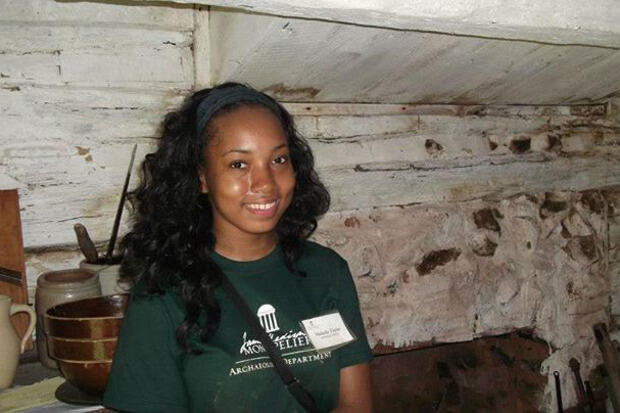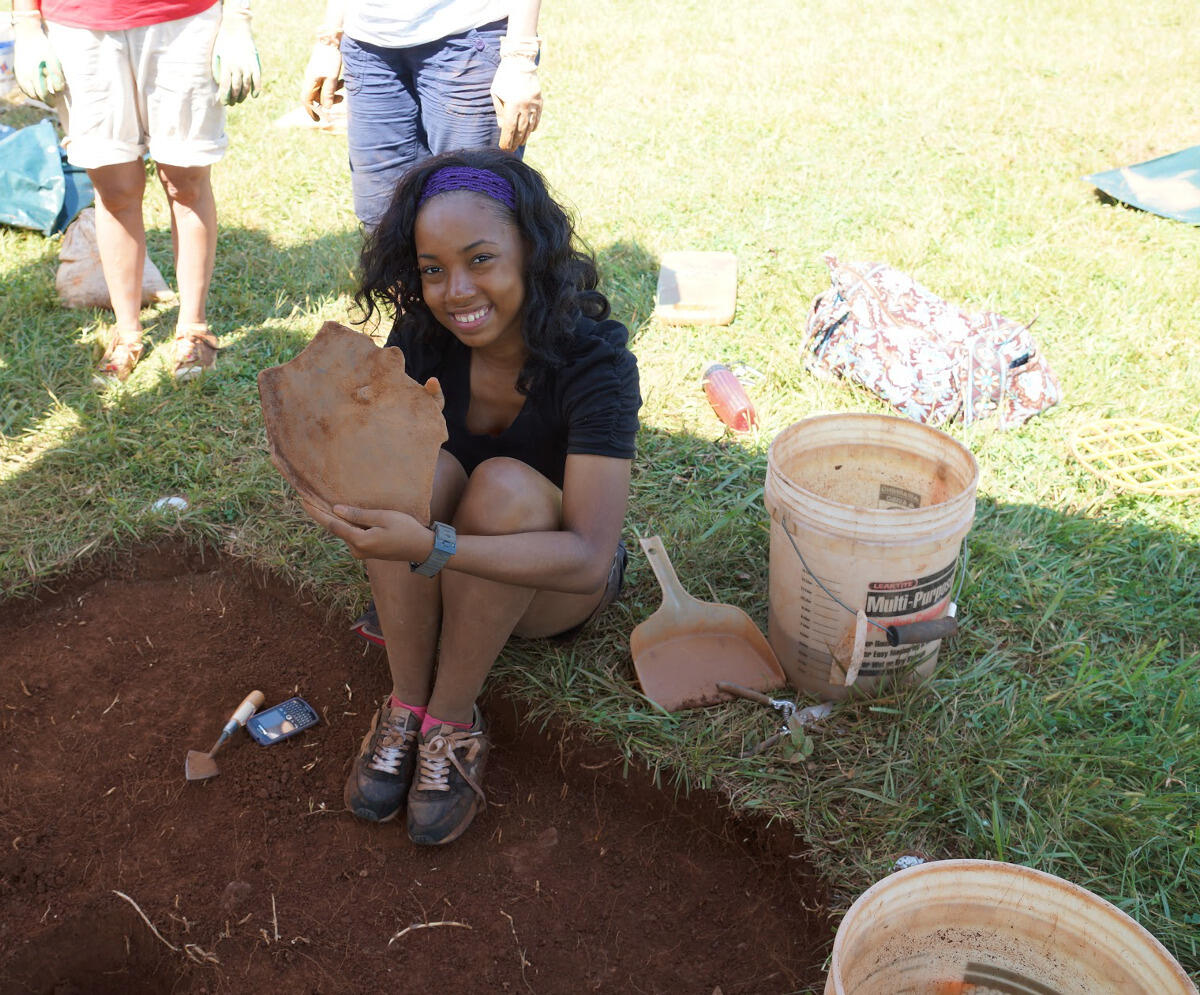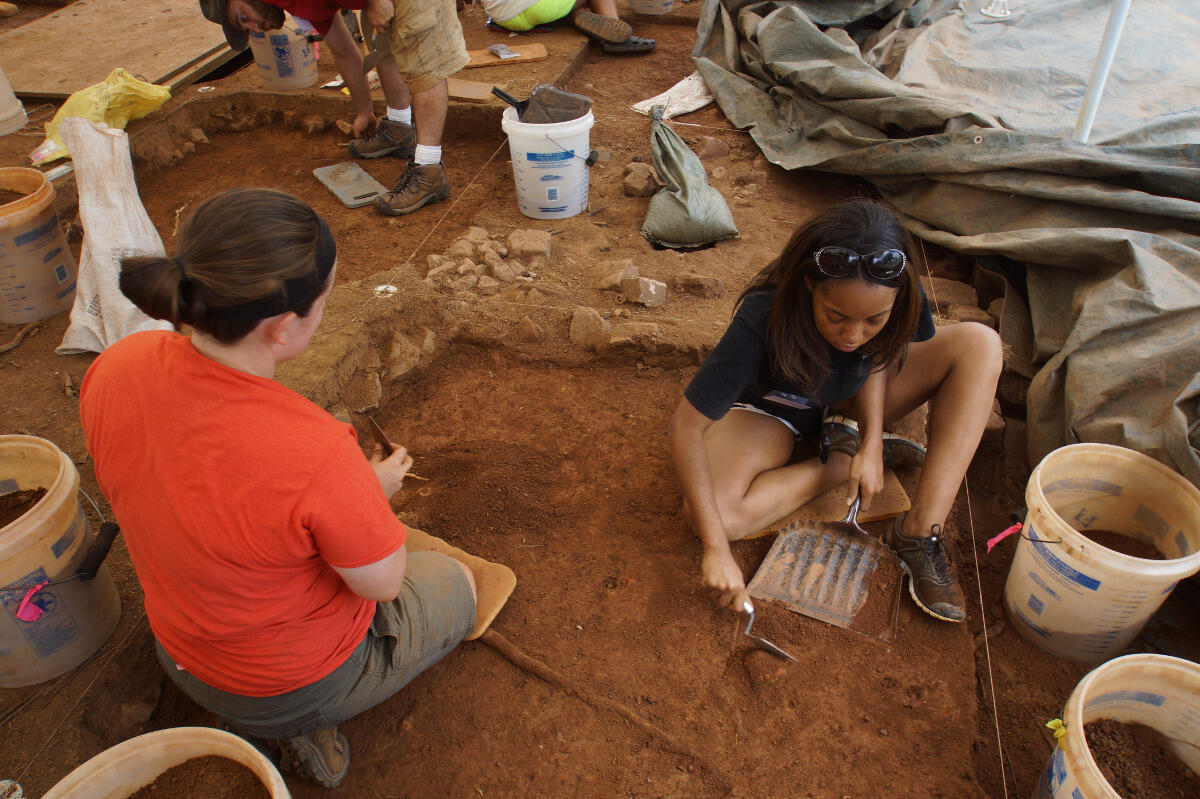
Sept. 11, 2015
Anthropology major uncovers her family ties to slavery at James Madison’s Montpelier
Share this story
While studying anthropology at Virginia Commonwealth University, Michelle Taylor took part in an archaeological dig to excavate artifacts from the field slave quarters at Montpelier, the home of James Madison.
As it turned out, Taylor not only discovered several items — such as a broken iron Dutch oven — she also uncovered her own family connections to the site.
Her ancestor, George Gilmore, was among Madison’s slaves and continued to live at Montpelier after Madison’s death in 1836 and then as a freedman after emancipation. His log cabin, built in the early 1870s from the remains of a deserted Confederate camp, has been restored and today stands as the first preserved and interpreted freedman’s home in the United States.
“I had a class with my [anthropology] professor, Bernard Means, and told him that I had some family up at Montpelier. He said, ‘Oh well, you know there’s a home up there, you should check it out,’” Taylor said. “So I Googled my family member’s name, and I found out that his house is still there. I was like, ‘What? No way!’”

Taylor, who is from Detroit, found photos from a 2001 event at which Montpelier invited descendants of Gilmore to join their archaeologists in excavating the Gilmore Cabin site. In the photos, she recognized several familiar faces.
“I had added George Gilmore to my family tree, but I didn’t really know anything about him. When I Googled him, I found the pictures from when Montpelier had descendants of George Gilmore come out to help excavate the site. I was looking at those pictures and thought, ‘Wait, those are my cousins!’”
Gilmore, she said, is her granduncle’s wife’s great-great-grandfather. “[My cousin] had told me about his family being from Virginia. When I was writing down our family names, I realized that the Gilmore name was connected to the Madisons.”
Matt Reeves, Ph.D., director of archaeology and landscape restoration at Montpelier, said Montpelier is thrilled to connect with Gilmore descendants such as Taylor.
“Having a descendant involved in excavations is very exciting for us,” he said. “We have an active public archaeology program where members of the public can spend a week digging with us. Through this program, we have made scholarships available for members of the local African-American community and descendants to come out and spend the week excavating with us.”
When I started researching my own family and seeing how it connected to an American president, everything just kind of came together for me.
Taylor graduated in August from the School of World Studies in the College of Humanities and Sciences as an anthropology and Spanish double major.
Discovering her personal connection to Gilmore has given Taylor, who has long been interested in genealogical research, a deeper understanding of enslaved people and strengthened her pride in her family history.
“I’ve always loved history, but I couldn’t ever really connect with it personally,” she said. “I knew some of my family’s history, but I didn’t know how it connected to American history and African-American history. So when I started researching my own family and seeing how it connected to an American president, everything just kind of came together for me.”
The experience also reinforced her decision to study anthropology, she added.
“It was amazing to discover [my connections]. It made me appreciate being an anthropology major,” she said. “I want to be the person who uncovers history. Everyone told me, there’s not a lot of African-Americans in archaeology. But I just loved it and felt like this is for me.”
Means, Taylor’s former professor, said Taylor quickly stood out as a student because of her creative way of approaching her anthropology classes and because of her dedication to genealogy and archaeology.
“The fact that Michelle can make a personal connection to someone at an archaeological site where she does archaeology melds together every aspect of her interests,” Means said. “Her ability to communicate her research and her enthusiasm is infectious, and I hear only positive comments from everyone with whom she interacts.”
Over the summer, Taylor interned in VCU’s Virtual Curation Laboratory, which is led by Means and which specializes in the 3-D scanning and printing of historic artifacts for analysis and conservation. Taylor worked with a variety of artifacts, including ones from Jamestown and Montpelier.
“I learned the ins and outs of 3-D printing and scanning and we reproduced artifacts from both sites, along with [items from] countless other historical sites throughout the world,” she said.
Taylor’s 3-D printing and scanning skills recently helped her land a job with VCU Libraries. This month, she started working at VCU’s James Branch Cabell Library as a library assistant for Innovative Media. When VCU Libraries’ new library opens, it will include an Innovative Media Studio with 3-D printers and scanners, laser cutters and many other makerspace tools.

Reeves said Montpelier is also interested in bringing Taylor back for an internship in Montpelier’s archaeology lab. “This would be a great experience for her to put on her resume and for her personally — working at the place where her ancestors lived and worked,” he said.
Taylor said she is also now attempting to find other Montpelier slave descendants.
“I’m trying to find more descendants of other people who were enslaved at the estate,” she said. “[Montpelier] has many scholarships available for descendants to participate in excavations, so it’d be great to find them and let them know.”
Subscribe to the weekly VCU News email newsletter at http://newsletter.news.vcu.
Subscribe to VCU News
Subscribe to VCU News at newsletter.vcu.edu and receive a selection of stories, videos, photos, news clips and event listings in your inbox.






